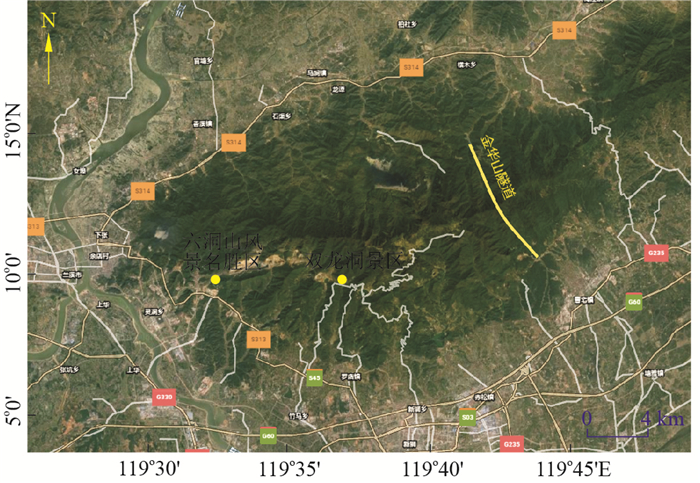Analysis of source and path of water inrush in karst tunnel based on the theory of groundwater flow system
-
摘要: 双龙洞是国家重点风景名胜区,拟建金华山隧道位于浙江省金华市双龙洞景区北东向约12 km处,金华山隧道的开挖将可能导致双龙洞景区岩溶水的疏干,同时隧道也可能遭受岩溶涌突水的安全隐患。基于地下水流系统理论,结合研究区水文地质条件调查成果,岩溶地下水流系统的划分,隧道出口段关键岩溶分布区地质结构的分析,以及水文地球化学测试分析结果,对双龙洞与隧址区之间各岩溶地下水流系统间的水力联系及涌突水可能性进行了分析。结果表明,隧道出口段开挖若揭露至其所处岩溶含水层并进行排水,影响的只是周边有限的岩溶水及裂隙水,不会直接连通研究区西侧大规模岩溶地下水流系统;隧道施工和运行期间对双龙洞景区的岩溶水基本不会产生影响,同时双龙洞岩溶水也不会对隧道出口段形成直接的涌突水威胁。在岩溶区隧道涌突水来源的研究中,基于地下水流系统理论合理划分岩溶地下水流系统并分析各系统间水力联系,是分析涌突水来源及防范涌突水灾害的必要前提。Abstract: Shuanglong Cave is a famous national scenic spot.The proposed Jinhua Mountain Tunnel is located about 12 km northeast of the Shuanglong Cave Scenic Area in Jinhua City, Zhejiang Province.The excavation of the Jinhua Mountain Tunnel may cause the karst water in Shuanglong Cave Scenic Area to be drained.At the same time, the tunnel may also be possiblely suffer the danger of karst water inrush.Based on the theory of groundwater flow system, combined with the survey results of hydrogeological conditions in the study area, the division of karst groundwater flow systems, the analysis of the geological structure of the key karst distribution areas at the exit of the tunnel, and the results of hydrogeochemical tests, the hydraulic connection between the two karst groundwater flow systems where the Shuanglong Cave and the tunnel site are located and the possibility of water inrush were analyzed.The results show that: if the tunnel exit section is exposed to the karst aquifer and drained, it will only affect the limited karst groundwater and fissure water around it, and will not directly connect to the large-scale karst groundwater flow system on the west side of the study area; during the tunnel construction and operation period, the karst groundwater in the Shuanglong Cave Scenic Area will basically not be affected, and the karst groundwater in the Shuanglong Cave will not pose a direct threat of water inrush at the exit section of the tunnel.In the study of water inrush source in karst areas, the rational division of karst groundwater flow systems based on the theory of groundwater flow system and analysis of the hydraulic connections between the systems are necessary prerequisites for analyzing the source of water inrush and preventing water inrush disasters.
-
Key words:
- groundwater flow system theory /
- Shuanglong Cave /
- Jinhua Mountain Tunnel /
- karst /
- water inrush
-
表 1 研究区岩溶地下水流系统划分
Table 1. Classification of karst groundwater flow systems in the study area
岩溶含水系统 岩溶地下水流系统模式 岩溶地下水流系统编号 岩溶地下水流系统名称 水流系统边界 排泄标高/ m 地貌类型 岩溶地下水流系统面积/km2 东侧 北侧 西侧 南侧 梅坞口F2断裂- 玲珑岩F5断裂岩溶含水系统 集中型排泄 Ⅰ 洞源 鸟窠岩与玲珑岩之间分水岭 劳村组与栖霞组地层分界线 F2断裂 船山组与藕塘底组地层分界线 80~ 120 中低山- 低山 3.96 分散型排泄 Ⅱ 玲珑岩 F5断裂 劳村组与栖霞组地层分界线 鸟窠岩与玲珑岩之间分水岭 船山组与藕塘底组地层分界线 460~ 500 中低山 0.48 玲珑岩F5断裂- 里湖坑F9断裂岩溶含水系统 集中型排泄 Ⅲ 双龙洞 鹿田水库所在沟谷 栖霞组与劳村组地层分界线 F5断裂 船山组与藕塘底组地层分界线 400~ 440 2.58 分散型排泄 Ⅳ 斗鸡岩 锣鼓山山脊线 船山组、栖霞组与劳村组地层分界线 鹿田水库所在沟谷 船山组与藕塘底组地层分界线 510~ 560 0.56 Ⅴ 洞殿下 F9断裂 劳村组与栖霞组地层分界线 锣鼓山山脊线 船山组与藕塘底组地层分界线 340~ 400 1.63 里湖坑F9断裂- F10断裂岩溶含水系统 Ⅵ 里湖坑 侵入岩 船山组和劳村组地层分界线 F9断裂 船山组与藕塘底组地层分界线 360~ 400 中低山- 低山 0.38 石桥F10断裂- F12断裂岩溶含水系统 Ⅶ 石桥 F12断裂 F10断裂 侵入岩 F11断裂 240~ 260 0.55 东宝寺F12断裂- F13断裂岩溶含水系统 Ⅷ 东宝寺 F13断裂、船山组与藕塘底组地层分界线 劳村组与栖霞组地层分界线 F12断裂 F14断裂 200~ 230 0.19 表 2 研究区各岩溶地下水流系统之间水力联系分析
Table 2. Analysis of hydraulic connection among various karst groundwater flow systems in the study area
岩溶地下水流系统名称 相邻岩溶地下水流系统间水力联系分析[11] 系统间水力联系分析结论 洞源(Ⅰ) 系统Ⅰ与系统Ⅱ交界处为鸟窠岩与玲珑岩之间的地表分水岭,系统内地下分水岭与地表分水岭基本一致。系统Ⅰ中岩溶水自该分水岭由东向西径流,系统Ⅱ西侧的岩溶水自该分水岭由西向东径流,2个岩溶水流系统岩溶地下水流系统之间没有水力联系通道 岩溶地下水流系统之间水力联系弱 玲珑岩(Ⅱ) 系统Ⅱ与系统Ⅲ交界处为F5断裂带,F5断层为区域大型NE向断层,为逆断层,断裂倾角70~80°。该断层以压扭性为主,断层带岩体较破碎,泥质胶结,以隔水效应为主。且该断层完全错开两侧灰岩分布区,错距约500 m 岩溶地下水流系统之间水力联系弱 双龙洞(Ⅲ) 系统Ⅲ与系统Ⅳ界处为鹿田沟谷。该沟谷所在位置绝对高程大于其东西两侧相邻沟谷(R8,R6)的高程,高差50~200 m。因此鹿田沟尽管在“局部水流系统”的尺度上是其紧邻两侧地下水的排泄带,但是在“中间水流系统或区域水流系统”尺度上可作为系统Ⅲ与系统Ⅳ的补给区,也即具备“分水岭”作用 岩溶地下水流系统之间水力联系弱 斗鸡岩(Ⅳ) 系统Ⅳ与系统Ⅴ交界处为锣鼓山一带地表分水岭,该分水岭与两侧相邻沟谷(R8、R9)高差约200~300 m,而本系统内地下分水岭与地表分水岭基本一致,因此地下水流从该分水岭分别向系统Ⅳ与系统Ⅴ排泄。另地表分水岭穿过2条东西向断层,断层为压扭性质,泥质胶结,以隔水效应为主 岩溶地下水流系统之间水力联系弱 洞殿下(Ⅴ) F9断层是系统Ⅴ与系统Ⅵ的共同边界,但存在约100 m的错距。由于在2个岩溶水流系统岩溶地下水流系统的错开段,F9断层两侧分别为劳村组(K1l1)含砾砂岩和藕塘底组(C2o)石英砂岩的相对隔水岩组,且该断层为压扭性质,亦以隔水效应为主 岩溶地下水流系统之间水力联系弱 里湖坑(Ⅵ) 系统Ⅵ与系统Ⅶ之间存在一条宽约300 m的NE向花岗斑岩岩脉,该岩脉与两侧岩溶水流系统岩溶地下水流系统均呈断层接触,断层面产状为300°∠67°。花岗斑岩脉具有隔水性,且将2个岩溶水流系统岩溶地下水流系统完全隔断 岩溶地下水流系统之间水力联系弱 石桥(Ⅶ) 系统Ⅶ与系统Ⅷ之间存在一条F12断裂,是2个系统的共同边界,但存在约100 m的错距。在2个岩溶地下水流系统的错开段,F12断层两侧分别为劳村组(K1l1)含砾砂岩和藕塘底组(C2o)石英砂岩的相对隔水岩组,且该断层为压扭性质,亦以隔水效应为主 岩溶地下水流系统之间水力联系弱 东宝寺(Ⅷ) -
[1] 罗明明, 周宏, 郭绪磊, 等. 峡口隧道间歇性岩溶涌突水过程及来源解析[J]. 地质科技通报. 2021, 40(6): 246-254. doi: 10.19509/j.cnki.dzkq.2021.0054Luo M M, Zhou H, Guo X L, et al. Processes and sources identification of intermittent karst water inrush in Xiakou tunnel[J]. Bulletin of Geological Science and Technology, 2021, 40(6): 246-254(in Chinese with English abstract). doi: 10.19509/j.cnki.dzkq.2021.0054 [2] 刘强, 刘运来, 徐志华, 等. 岩溶隧道图用水来源及路径分析[J]. 铁道建筑, 2016, 60(10): 63-66. doi: 10.3969/j.issn.1003-1995.2016.10.17Liu Q, Liu Y L, Xu Z H, et al. Analysis on source and path of gushing water in karst tunnel[J]. Railway Engineering, 2016, 60(10): 63-66. (in Chinese with English abstract). doi: 10.3969/j.issn.1003-1995.2016.10.17 [3] 李志源, 王维富, 徐学存. 岩溶隧道涌水来源及对地下水环境的影响[J]. 铁道建筑, 2016, 60(9): 78-82. https://www.cnki.com.cn/Article/CJFDTOTAL-TDJZ202009019.htmLi Z Y, Wang W F, Xu X C, et al. Source of gushing water in karst tunnel and its influence on groundwater environment[J]. Railway Engineering, 2016, 60(9): 78-82(in Chinese with English abstract). https://www.cnki.com.cn/Article/CJFDTOTAL-TDJZ202009019.htm [4] 张人权, 梁杏, 靳孟贵, 等. 水文地质学基础[M]. 第7版. 北京: 地质出版社, 2018.Zhang R, Liang X, Jin M, et al. Fundamentals of hydrogeology[M]. 7th Edition. Beijing: Geological Publishing House, 2018(in Chinese). [5] Tóth J. Gravitational system of groundwater: Theory, evaluation, utilization[M]. Cambridge: Cambridge University Press, 2009. [6] 梁杏, 张婧玮, 蓝坤, 等. 江汉平原地下水化学特征及水流系统分析[J]. 地质科技通报, 2020, 39(1): 21-33. doi: 10.19509/j.cnki.dzkq.2020.0103Liang X, Zhang J W, Lan K, et al. Hydrochemical characteristics of groundwater and analysis of groundwater flow systems in Jianghan Plain[J]. Bulletin of Geological Science and Technology, 2020, 39(1): 21-33(in Chinese with English abstract). doi: 10.19509/j.cnki.dzkq.2020.0103 [7] 王喆. 岩溶地下水系统演化的数值模拟[J]. 地质科技情报, 2013, 32(4): 201-206. https://www.cnki.com.cn/Article/CJFDTOTAL-DZKQ201304032.htmWang Z. Numerical simulation of the karst groundwater system evolution[J]. Geological Science and Technology Information, 2013, 32(4): 201-206(in Chinese with English abstract). https://www.cnki.com.cn/Article/CJFDTOTAL-DZKQ201304032.htm [8] 韩行瑞. 岩溶水文地质学[M]. 北京: 科学出版社, 2015.Han X R. Karst hydrogeology[M]. Beijing: Science Press, 2015(in Chinese). [9] 陈梦熊. 地下水系统理论的引进与实践[J]. 中国科学院院刊, 1993, 8(2): 147-148. https://www.cnki.com.cn/Article/CJFDTOTAL-KYYX199302014.htmChen M X. Introduction and practice of groundwater system theory[J]. Bulletin of Chinese Academy of Sciences, 1993, 8(2): 147-148(in Chinese with English abstract). https://www.cnki.com.cn/Article/CJFDTOTAL-KYYX199302014.htm [10] 张人权, 梁杏. 构造定量分析在岩溶水研究中的应用[J]. 地质科技情报, 1998, 17(2): 15-19. https://www.cnki.com.cn/Article/CJFDTOTAL-DZKQ8S2.003.htmZhang R Q, Liang X. Application of quantitative structural analysis in karst-water research[J]. Geological Science and Technology Information, 1998, 17(2): 15-19(in Chinese with English abstract). https://www.cnki.com.cn/Article/CJFDTOTAL-DZKQ8S2.003.htm [11] 张人权, 王恒纯, 许绍倬. 水文地质研究中信息的提取与组织[J]. 水文地质工程地质, 1990, 17(2): 12-29. https://www.cnki.com.cn/Article/CJFDTOTAL-SWDG199002001.htmZhang R Q, Wang H C, Xu S Z. Extraction and organization of information in hydrogeological research[J]. Hydrogeology & Engineering Geology, 1990, 17(2): 12-29(in Chinese with English abstract). https://www.cnki.com.cn/Article/CJFDTOTAL-SWDG199002001.htm [12] 张人权. 关于水文地质学的一些思考[J]. 地质科技情报, 2002, 21(1): 1-6. https://www.cnki.com.cn/Article/CJFDTOTAL-DZKQ200201002.htmZhang R. Some thinking ondevelopment of hydrogeology[J]. Geological Science and Technology Information, 2002, 21(1): 1-6(in Chinese with English abstract). https://www.cnki.com.cn/Article/CJFDTOTAL-DZKQ200201002.htm [13] 袁道先. 岩溶地区的地质环境和水文生态问题[J]. 南方国土资源, 2003(1): 22-25. https://www.cnki.com.cn/Article/CJFDTOTAL-GXDZ200301007.htmYuan D X. Geological environment and hydrological ecological problems in karst regions[J]. Southern Land and Resources, 2003(1): 22-25(in Chinese with English abstract). https://www.cnki.com.cn/Article/CJFDTOTAL-GXDZ200301007.htm [14] Goldscheider N, Drew D. Methods in karst hydrogeology[M]. London: Taylor & Francis Group, UK, 2007. -





 下载:
下载:











